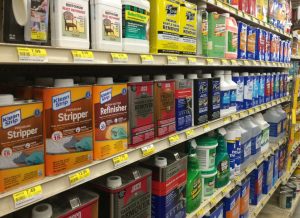 On April 28, while thousands of Americans were commemorating Workers Memorial Day, 21 year old Kevin Hartley was hard at work stripping a bathtub. Co-workers found Kevin unconscious and rushed him to the hospital where he died later that afternoon of cardiac arrest.
On April 28, while thousands of Americans were commemorating Workers Memorial Day, 21 year old Kevin Hartley was hard at work stripping a bathtub. Co-workers found Kevin unconscious and rushed him to the hospital where he died later that afternoon of cardiac arrest.
Harley’s death wasn’t caused by a rare congenital disorder or a freak accident. He was killed by chemical fumes from a paint stripper he was using to refinish the bathtub. The paint stripper, containing methylene chloride, can be purchased in any hardware store and has been the cause of dozens of deaths over the past several years.
A 2014 Center for Public Integrity investigation highlighted the 1990 death of 18 year old Johnathan Welch who was “working through lunch when the fumes killed him, stealing oxygen from his brain, stopping his heart.”
A Center analysis identified at least 56 accidental exposure deaths linked to methylene chloride since 1980 in the U.S. Thirty-one occurred before Johnathan Welch died, 24 after. The most recent was in July. Many involved paint strippers; in other cases victims used the chemical for tasks such as cleaning and gluing carpet, according to death investigations and autopsy reports the Center obtained through Freedom of Information Act and state open records requests.
Teenagers on the job, a mother of four, workers nearing retirement, an 80-year-old man — the toxic vapors took them all. A Colorado resident one year older than Welch was killed his first day at a furniture-stripping shop. Three South Carolina workers were felled in a single incident in 1986. Church maintenance employee Steve Duarte, 24, survived the Iraq War only to be killed in 2010 while stripping a baptismal pool in California.
“Methylene chloride transforms in the body to carbon monoxide, giving it another way to kill — by triggering a heart attack from lack of oxygen. And while methylene chloride isn’t flammable, an open flame can convert it to phosgene, the poisonous gas that killed tens of thousands in World War I.” Methylene chloride also causes cancer and OSHA issued a standard controlling the level of MC in the 1990’s, but OSHA has no authority to ban chemicals.
Help may be at hand. Last January, the Environmental Protection Agency (EPA),under authority granted by last year’s revision of the Toxic Substances Control Act, declared the risks of MC unreasonable and proposed to “prohibit the manufacture (including import), processing, and distribution in commerce of methylene chloride for consumer and most types of commercial paint and coating removal.” The EPA would also require manufacturers, importers, processors, and distributors (except for retailers), of methylene chloride “to provide downstream notification of these prohibitions throughout the supply chain; and to require recordkeeping.”

The European Union pulled methylene chloride paint strippers from general use in 2011. In 2016, OSHA issued an alert on “Lethal Exposure to Methylene Chloride during Bathtub Refinishing” and stating that “Employers are strongly encouraged to provide safer alternatives to methylene chloride paint stripping products.” The California Department of Public Health has a fact sheet listing safer alternatives.
EPA also proposed a second option, to reformulate MC at lower concentration, and rely on improved labeling and other worker protection actions like improved gloves and training. OSHA already requires personal protective equipment in some situations and worker training. The Environmental Defense Fund, which is spearheading efforts to ban the chemical, strongly opposes this second option:
Not only has EPA failed to provide adequate justification… that such an approach would sufficiently mitigate the unreasonable risk, but this approach would cost much more both for the regulated community and EPA. Given the availability of safer alternatives, there is no reasonable rationale to continue to put the public’s health at risk.
But now we’re in Trump times. How will Trump’s Executive Order that requires two regulations to be removed for every one that’s added affect the methylene chloride ban? Will EPA be required to find two previously banned chemicals and allow them to start killing workers and the public again?
Kevin Hartley’s parents’ only consolation is that he was an organ donor:
In a biography read to the organ team and shared with the recipients of his organs, Kevin is described as lighting up the room with his smile. He worked with his dad, uncle and brother and had a strong work ethic, reads the biography. “He jokes that one day he will own the family business and supervise everyone to make sure they are working hard.”
“Kevin is a wonderful person and will be missed by all his friends and family,” the biography reads. “We are so happy he has the opportunity to continue to bless the lives of so many, as he always has.”
In 1982, I accidentally poisoned myself by thinking I could hold my breath by reaching for my car keys after my husband set off a flea fogger inside the house. The product was DDVP, banned later because if caused sterility in men, not because it damaged my brain, causing cognitive damage. Ten years later and with long term as well as short term memory loss, I was using a floor stripper, but I had on the wrong mask, the wrong gloves, and even though I had the best fresh air entering the room, I was inadequately protected from the highly toxic product. In both cases, the labeled ingredients were MIXED XYLENE ISOMERS. In both cases, the label said what it contained, and some of the misleading symptom: numbness, pins and needles, short tern cognitive effects, defatting of skin. The label said to wear protective gloves and a protective mask, but should have said to wear elbow length Industrial NITRILE gloves and a respiratory chemical mask. I had a dust mask on. The hardware stor should not have sold me the chemical at all without seeing my source of protection. And I not having studied chemistry did not know what I was getting..
I know now, what I experienced. It took over a year for my skin to stop peeling as if I had frost bite, and another year of constant shea butter to soften. My memory is improving as long as I am in a well aerated exteior, and am extremely careful when filling up the car with gasoline. But it’s been decades since I was poisoned.
I credit organic agriculture with saving my life, and now only clean using vinegar and baking soda, or Shaklee far less dangerous products. NOTHING IS WORTH ENDANGERING your health over. I stay outside when painting occurs, and I don’t do the painting. I have to use paper tape instead of adhesive plastic tape. I’ve learned a lot and now know where to find more information on products and chemicals ti take PRECAUTIONS, because the CHEMICAL INDUSTRY, the Republican Party in Congress and the Senate, and the TRUMP White House allows people to be poisoned so corporations can profit with dangerous petrochemical technologies and toxic heavy metal fertilizers.
[…] (MC) last month after they had been promised by former EPA Administrator Scott Pruitt. Hartley died in 2017 while using methylene chloride to strip a bathtub. He was 21 years […]